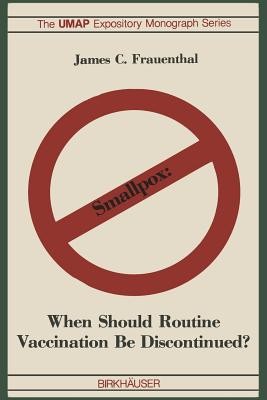
- We will send in 10–14 business days.
- Author: J C Frauenthal
- Publisher: Birkhäuser
- ISBN-10: 0817630422
- ISBN-13: 9780817630423
- Format: 15.2 x 22.9 x 0.3 cm, minkšti viršeliai
- Language: English
- SAVE -10% with code: EXTRA
Smallpox: When Should Routine Vaccination Be Discontinued? (e-book) (used book) | bookbook.eu
Reviews
Description
The material discussed in this monograph should be accessible to upper level undergraduates in the mathemati- cal sciences. Formal prerequisites include a solid intro- duction to calculus and one semester of probability. Although differential equations are employed, these are all linear, constant coefficient, ordinary differential equa- tions which are solved either by separation of variables or by introduction of an integrating factor. These techniques can be taught in a few minutes to students who have studied calculus. The models developed to describe an epidemic outbreak of smallpox are standard stochastic processes (birth-death, random walk and branching processes). While it would be helpful for students to have seen these prior to their introduction in this monograph, it is certainly not necessary. The stochastic processes are developed from first principles and then solved using elementary tech- niques. Since all that turns out to be necessary are ex- pected values of random variables, the differential-differ- ence equatlon descriptions of the stochastic processes are reduced to ordinary differential equations before being solved. Students who have studied stochastic processes are generally pleased to learn that different formulations are possible for the same set of conditions. The choice of which formulation to employ depends upon what one wishes to calculate. Specifically, in Section 6 a birth-death pro- cess is replaced by a random walk and in Section 7 a prob- lem is formulated both as a multi-birth-death process and as a branching process.
EXTRA 10 % discount with code: EXTRA
The promotion ends in 22d.00:34:20
The discount code is valid when purchasing from 10 €. Discounts do not stack.
- Author: J C Frauenthal
- Publisher: Birkhäuser
- ISBN-10: 0817630422
- ISBN-13: 9780817630423
- Format: 15.2 x 22.9 x 0.3 cm, minkšti viršeliai
- Language: English English
The material discussed in this monograph should be accessible to upper level undergraduates in the mathemati- cal sciences. Formal prerequisites include a solid intro- duction to calculus and one semester of probability. Although differential equations are employed, these are all linear, constant coefficient, ordinary differential equa- tions which are solved either by separation of variables or by introduction of an integrating factor. These techniques can be taught in a few minutes to students who have studied calculus. The models developed to describe an epidemic outbreak of smallpox are standard stochastic processes (birth-death, random walk and branching processes). While it would be helpful for students to have seen these prior to their introduction in this monograph, it is certainly not necessary. The stochastic processes are developed from first principles and then solved using elementary tech- niques. Since all that turns out to be necessary are ex- pected values of random variables, the differential-differ- ence equatlon descriptions of the stochastic processes are reduced to ordinary differential equations before being solved. Students who have studied stochastic processes are generally pleased to learn that different formulations are possible for the same set of conditions. The choice of which formulation to employ depends upon what one wishes to calculate. Specifically, in Section 6 a birth-death pro- cess is replaced by a random walk and in Section 7 a prob- lem is formulated both as a multi-birth-death process and as a branching process.


Reviews